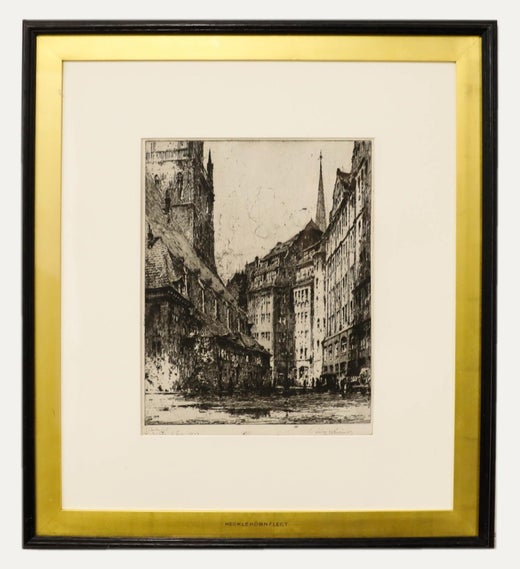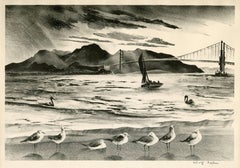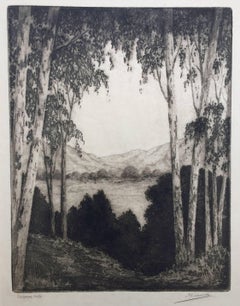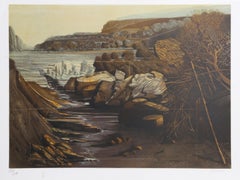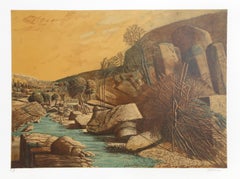Items Similar to Golden Gate, San Francisco, California
Want more images or videos?
Request additional images or videos from the seller
1 of 9
Luigi KasimirGolden Gate, San Francisco, Californiac.1930
c.1930
$575
£435.67
€499.90
CA$809.12
A$889.44
CHF 467.45
MX$10,801.08
NOK 5,831.33
SEK 5,524.77
DKK 3,730.87
About the Item
This artwork titled "Golden Gate, San Francisco, California" c.1930 is a color etching on watermarked Kasimir Vienna paper by Austrian artist Luigi Kasimir, 1881-1962. It is hand signed in pencil by the artist's estate at the lower center. The plate mark (image) size is 11 x 12 inches, the sheet size is 21 x 17.5 inches. With full margin. it is in excellent condition, has never been framed.
About the artist.
Luigi Kasimir was born in 1881 at Pettau, today Ptuj, Slovenia, then a part of the Austro-Hungarian monarchy. He inherited his talent from his ancestors; his grandfather was a painter and a poet, and his father an officer in the Habsburg army, who later became a professional painter. Kasimir attended the Vienna Academy of Art where he studied under Wilhelm Unger, who introduced him to the technique of the coloured etching, and also to his future wife, the artist Tanna Hoernes.[1] He died in 1962 in Grinzing, a suburb of Vienna.Kasimir was among the first to develop the technique of the coloured etching. Before this, prints were usually hand-coloured with the colour being applied in a casual, haphazard manner. Kasimir would first create a sketch usually in pastel, he then transferred the design on as many as four to six plates, printing one after the other and applying the colour on the plate, all done by hand.
Kasimir is mainly famous for his etchings, but he also produced some oil painting, as well as some pastels. One of his favourite genres was the landscape, or veduta. He demonstrated a predisposition street scenes, and tourist landmarks. He depicted places from all over Europe, mainly Italy, Austria, and Germany. He also travelled to the United States to do a series of etchings of famous sights ranging from urban landmarks such as New York City skyscrapers, to natural wonders like Yosemite Valley. Luigi Kasimir’s etchings can be seen in many galleries and museums, from the New York Metropolitan Museum of Art to countless galleries and fine print collections around the world.
- Creator:Luigi Kasimir (1881 - 1962, Austro-Hungarian)
- Creation Year:c.1930
- Dimensions:Height: 19.15 in (48.65 cm)Width: 19 in (48.26 cm)Depth: 0.01 in (0.26 mm)
- Medium:
- Movement & Style:
- Period:
- Condition:
- Gallery Location:San Francisco, CA
- Reference Number:Seller: Kas/gol/gat/011stDibs: LU66637121392
Luigi Kasimir
Alois Heinrich “Luigi” Kasimir (Austrian, 1881-1962) was born on April 18, 1881 in Ptuj, Austria (today Slovenia) then a part of the Austro-Hungarian monarchy. He may have inherited his talent from his ancestors; his grandfather was a painter and a poet, and his father, an officer in the Habsburg army, who later became a professional painter. Kasimir attended the Vienna Academy of Art where he studied under Willhelm Unger, who introduced him to the technique of the color etching, and also to his future wife, the artist Tanna Hoernes. Kasimir was among the early practitioners of the multi-plate color etching. Before this, prints were usually hand-colored with the color being applied in a casual, haphazard manner. Kasimir would first create a sketch—usually in pastel. He then transferred the design on as many as four to six plates, printing one after the other and applying the color to the plate - all done by hand. Although Luigi Kasimir is mainly famous for his etchings, but he also produced some oil painting, as well as some pastels. One of his favorite genres was the landscape. He demonstrated a predisposition for monuments, street scenes, and tourist landmarks. He depicted places from all over Europe, mainly Italy, Austria, and Germany. He also travelled to the United States to do a series of etchings of famous sights ranging from urban landmarks such as New York skyscrapers to natural wonders like California’s Yosemite Valley. Kasimir designed a bookplate for Sigmund Freud, who also hung an etching of the Roman Forum by Kasimir in his consulting room. Kasimir’s wife, Tanna and their son Robert worked in a similar style. Luigi Kasimir died in 1962 in Grinzing, a suburb of Vienna, Austria
About the Seller
5.0
Platinum Seller
Premium sellers with a 4.7+ rating and 24-hour response times
Established in 1999
1stDibs seller since 2017
839 sales on 1stDibs
Typical response time: 1 hour
- ShippingRetrieving quote...Shipping from: San Francisco, CA
- Return Policy
Authenticity Guarantee
In the unlikely event there’s an issue with an item’s authenticity, contact us within 1 year for a full refund. DetailsMoney-Back Guarantee
If your item is not as described, is damaged in transit, or does not arrive, contact us within 7 days for a full refund. Details24-Hour Cancellation
You have a 24-hour grace period in which to reconsider your purchase, with no questions asked.Vetted Professional Sellers
Our world-class sellers must adhere to strict standards for service and quality, maintaining the integrity of our listings.Price-Match Guarantee
If you find that a seller listed the same item for a lower price elsewhere, we’ll match it.Trusted Global Delivery
Our best-in-class carrier network provides specialized shipping options worldwide, including custom delivery.More From This Seller
View AllGolden Gate Bridge, San Francisco
By Fanch (Francois Ledan)
Located in San Francisco, CA
This artwork titled "Golden Gate Bridge, San Francisco" 1988 is a original colors lithograph on Arches paper by French artist (Fanch, Francois Ledan, born 1949) It is hand signed and inscribed A.P. (Artist Proof) in pencil by the artist. The image size is 26 x 19.5 inches, framed is 37.25 x 31.25 inches. Published and printed by Art Estampes, Paris. Custom framed in a wooden gold frame, with off white matting. It is in excellent condition, the frame has a minor restoration at the lower right side corner, practically invisible.
About the artist:
Francois "Fanch" Ledan (b. 1949) is noted for colorful scenes of his native Brittany. In 1968 he abandoned his studies in commercial design for full-time studies in painting and fine art. His talent was quickly recognized and soon he was involved in major European shows. He became involved in printmaking in 1973 when he learned lithography in Paris. Since then he has had numerous one-person shows in Europe, North America and South America.
His paintings and lithographs from the 1970's and 1980's display characteristics often associated with "naïve" art. His views of Paris, a city which has embraced naïve art, display the attention to detail,
In the 80's he turned to more brightly colored paintings and again a connection to Impressionism. He began to work on paintings that he refers to as "interiorscapes" or "interior visions...
Category
Late 20th Century Modern Landscape Prints
Materials
Lithograph
San Francisco, Fisherman's Wharf
By Josef Eidenberger
Located in San Francisco, CA
This artwork titled "San Francisco, Fisherman's Wharf" c.1975 is a color etching on Wove paper by noted Austrian artist Josef Eidenberger, 1899-1991. It is hand signed n pencil by th...
Category
Mid-20th Century Realist Figurative Prints
Materials
Etching
South San Francisco
Located in San Francisco, CA
This artwork "South San Francisco" 2003 Is a watercolor on paper by Filipino artist Ephraim Samson, b.1947. It is signed and dated at the lower right co...
Category
21st Century and Contemporary Realist Landscape Drawings and Watercolors
Materials
Watercolor
Mallorca Kuste, Spain
By Josef Eidenberger
Located in San Francisco, CA
This artwork titled "Mallorca Kuste, Spain" c.1960 is a color etching on Wove paper by noted Austrian artist Josef Eidenberger, 1899-1991. It is hand signed in pencil by the artist. Published/printed by Graphics International, Austria. The plate mark (image) size is 9.5 x 15.25 inches, sheet size is 16.75 x 21 inches. It is in excellent condition, has never been framed.
About the artist.
Josef Eidenberger was born in 1899 in the little town of Goisern, Austria,he began his artistic career as a landscape painter. In 1923 he enrolled in the famed Graphic Academy of Art in Vienna and studied under Professor Alfred Cossman.
His recognized talent brought him many commissions from city officials and members of the business communities throughout Europe, especially in Austria and Germany. In 1973 after visiting the United States for the first time he created a series of California etchings...
Category
Mid-20th Century Realist Figurative Prints
Materials
Etching
California Coast
Located in San Francisco, CA
This artwork "California Coast" 2003 Is a watercolor on paper by Filipino artist Ephraim Samson, b.1947. It is signed and dated at the lower right corne...
Category
21st Century and Contemporary Realist Landscape Drawings and Watercolors
Materials
Watercolor
Persenbeug Castle, Austria
By Luigi Kasimir
Located in San Francisco, CA
This artwork titled "Persenbeug Castle, Austria" c.1930 is a color etching and aquatint on watermarked Kasimir Vienna Wove paper by Austrian artist Luigi Kasimir, 1881-1962. It is ha...
Category
Early 20th Century Realist Figurative Prints
Materials
Etching
You May Also Like
The Golden Gate
By Adolf Arthur Dehn
Located in Fairlawn, OH
The Golden Gate
Lithograph on wove paper watermarked GC, 1940
Signed in pencil by the artist (see photo)
Publisher: Associated American Artists
Edition: 189, unnumbered
The image depicts The Golden Gate Bridge which connects San Francisco and Marin County, California
References And Exhibitions:
Illustrated: Adams, The Sensuous Life of Adolf Dehn, Fig. 13.17, page 324
Reference: L & O 325
AAA Index 391
Adolf Dehn, American Watercolorist and Printmaker, 1895-1968
Adolf Dehn was an artist who achieved extraordinary artistic heights, but in a very particular artistic sphere—not so much in oil painting as in watercolor and lithography. Long recognized as a master by serious print collectors, he is gradually gaining recognition as a notable and influential figure in the overall history of American art.
In the 19th century, with the invention of the rotary press, which made possible enormous print runs, and the development of the popular, mass-market magazines, newspaper and magazine illustration developed into an artistic realm of its own, often surprisingly divorced from the world of museums and art exhibitions, and today remains surprisingly overlooked by most art historians. Dehn in many regards was an outgrowth of this world, although in an unusual way, since as a young man he produced most of his illustrative work not for popular magazines, such as The Saturday Evening Post, but rather for radical journals, such as The Masses or The Liberator, or artistic “little magazines” such as The Dial. This background established the foundation of his outlook, and led later to his unique and distinctive contribution to American graphic art.
If there’s a distinctive quality to his work, it was his skill in introducing unusual tonal and textural effects into his work, particularly in printmaking but also in watercolor. Jackson Pollock seems to have been one of many notable artists who were influenced by his techniques.
Early Years, 1895-1922
For an artist largely remembered for scenes of Vienna and Paris, Adolf Dehn’s background was a surprising one. Born in Waterville, Minnesota, on November 22, 1895, Dehn was the descendent of farmers who had emigrated from Germany and homesteaded in the region, initially in a one-room log cabin with a dirt floor. Adolf’s father, Arthur Clark Dehn, was a hunter and trapper who took pride that he had no boss but himself, and who had little use for art. Indeed, during Adolf’s boyhood the walls of his bedroom and the space under his bed were filled with the pelts of mink, muskrats and skunks that his father had killed, skinned and stretched on drying boards. It was Adolf’s mother, Emilie Haas Dehn, a faithful member of the German Lutheran Evangelical Church, who encouraged his interest in art, which became apparent early in childhood. Both parents were ardent socialists, and supporters of Eugene Debs. In many ways Dehn’s later artistic achievement was clearly a reaction against the grinding rural poverty of his childhood.
After graduating from high school in 1914 at the age of 19—an age not unusual in farming communities at the time, where school attendance was often irregular—Dehn attended the Minneapolis School of Art from 1914 to 1917, whose character followed strongly reflected that of its director, Munich-trained Robert Kohler, an artistic conservative but a social radical. There Dehn joined a group of students who went on to nationally significant careers, including Wanda Gag (later author of best-selling children’s books); John Flanagan (a sculptor notable for his use of direct carving) Harry Gottlieb (a notable social realist and member of the Woodstock Art Colony), Elizabeth Olds (a printmaker and administrator for the WPA), Arnold Blanch (landscape, still-life and figure painter, and member of the Woodstock group), Lucille Lunquist, later Lucille Blanch (also a gifted painter and founder of the Woodstock art colony), and Johan Egilrud (who stayed in Minneapolis and became a journalist and poet).
Adolf became particularly close to Wanda Gag (1893-1946), with whom he established an intense but platonic relationship. Two years older than he, Gag was the daughter of a Bohemian artist and decorator, Anton Gag, who had died in 1908. After her husband died, Wanda’s mother, Lizzi Gag, became a helpless invalid, so Wanda was entrusted with the task of raising and financially supporting her six younger siblings. This endowed her with toughness and an independent streak, but nonetheless, when she met Dehn, Wanda was Victorian and conventional in her artistic taste and social values. Dehn was more socially radical, and introduced her to radical ideas about politics and free love, as well as to socialist publications such as The Masses and The Appeal to Reason.
Never very interested in oil painting, in Minneapolis Dehn focused on caricature and illustration--often of a humorous or politically radical character. In 1917 both Dehn and Wanda won scholarships to attend the Art Students League, and consequently, in the fall of that year both moved to New York. Dehn’s art education, however, ended in the summer of 1918, shortly after the United States entered World War I, when he was drafted to serve in the U. S. Army. Unwilling to fight, he applied for status as a conscientious objector, but was first imprisoned, then segregated in semi-imprisonment with other Pacifists, until the war ended. The abuse he suffered at this time may well explain his later withdrawal from taking political stands or making art of an overtly political nature. After his release from the army, Dehn returned to New York where he fell under the spell of the radical cartoonist Boardman Robinson and produced his first lithographs. He also finally consummated his sexual relationship with Wanda Gag.
The Years in Europe: 1922-1929
In September of 1921, however, he abruptly departed for Europe, arriving in Paris and then moving on to Vienna. There in the winter of 1922 he fell in love with a Russian dancer, Mura Zipperovitch, ending his seven-year relationship with Wanda Gag. He and Mura were married in 1926. It was also in Vienna that he produced his first notable artistic work.
Influenced by European artists such as Jules Pascin and Georg Grosz, Dehn began producing drawings of people in cafes, streets, and parks, which while mostly executed in his studio, were based on spontaneous life studies and have an expressive, sometimes almost childishly wandering quality of line. The mixture of sophistication and naiveté in these drawings was new to American audiences, as was the raciness of their subject matter, which often featured pleasure-seekers, prostitutes or scenes of sexual dalliance, presented with a strong element of caricature. Some of these drawings contain an element of social criticism, reminiscent of that found in the work of George Grosz, although Dehn’s work tended to focus on humorous commentary rather than savagely attacking his subjects or making a partisan political statement. Many Americans, including some who had originally been supporters of Dehn such as Boardman Robinson, were shocked by these European drawings, although George Grocz (who became a friend of the artist in this period) admired them, and recognized that Dehn could also bring a new vision to America subject matter. As he told Dehn: “You will do things in America which haven’t been done, which need to be done, which only you can do—as far at least as I know America.”
A key factor in Dehn’s artistic evolution at this time was his association with Scofield Thayer...
Category
1940s American Realist Landscape Prints
Materials
Lithograph
CALIFORNIA VISTA
By Harold Lukens Doolittle
Located in Santa Monica, CA
HAROLD L. DOOLITTLE (1883 – 1974)
CALIFORNIA VISTA, 1923
Aquatint signed and titled in pencil. 8 7/8 x 6 7/8 inches. Sheet 11 x 14 inches. Good condi...
Category
1920s American Realist Figurative Prints
Materials
Aquatint
$780 Sale Price
20% Off
Le Leze I, American Realist Lithograph by Ivan Theimer
By Ivan Theimer
Located in Long Island City, NY
Ivan Theimer, Czech (1944 - ) - Le Leze I, Year: 1982, Medium: Lithograph, signed and numbered in pencil, Edition: 200, Size: 21 in. x 30 in. (53.34 cm x 76.2 cm)
Category
1980s American Realist Landscape Prints
Materials
Lithograph
Le Leze IV, American Realist Lithograph by Ivan Theimer
By Ivan Theimer
Located in Long Island City, NY
Ivan Theimer, Czech (1944 - ) - Le Leze IV, Year: 1982, Medium: Lithograph, signed and numbered in pencil, Edition: 200, Size: 21 in. x 30 in. (53.34 cm x 76.2 cm)
Category
1980s American Realist Landscape Prints
Materials
Lithograph
Borrowed Landscapes Study No. 205/The Golden Gate Bridge, San Francisco, CA
By Nina Tichava
Located in Denver, CO
Nina Tichava is a pattern-based, abstract painter primarily focused on spatial relationships that emphasize the inherent surface quality, color, and visual variations in her work. Sh...
Category
2010s Abstract Mixed Media
Materials
Paper, Acrylic, Postcard, Pen, Graphite
Borrowed Landscapes Study No. 205/The Golden Gate Bridge, San Francisco, CA
By Nina Tichava
Located in Denver, CO
Nina Tichava is a pattern-based, abstract painter primarily focused on spatial relationships that emphasize the inherent surface quality, color, and visual variations in her work. Sh...
Category
2010s Abstract Mixed Media
Materials
Acrylic, Postcard, Pen, Graphite

